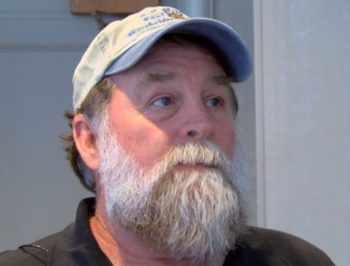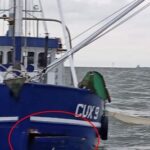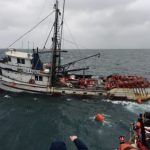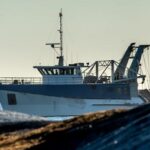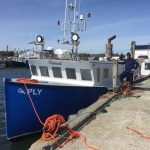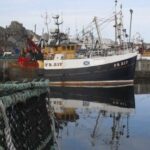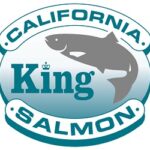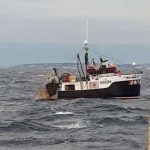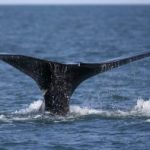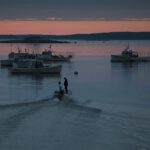Daily Archives: February 7, 2017
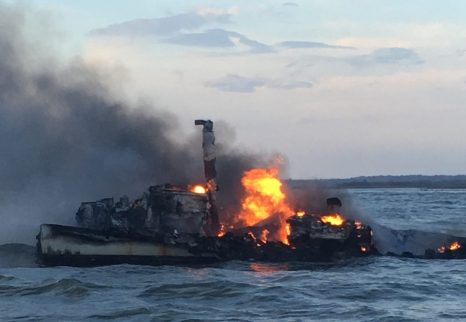
Coast Guard rescues 3 fishermen after vessel catches fire near St. Catherines Island, Ga.
The Coast Guard rescued three fishermen Tuesday after the fishing vessel they were on caught fire 1 mile east of St. Catherines Island, Georgia. Coast Guard Sector Charleston Command Center watchstanders received a call from a crew member aboard the fishing vessel Sea Puppy at 3:16 p.m. who stated their boat was on fire and taking on water. A Coast Guard Station Tybee Island 29-foot Response Boat – Small boat crew and an Air Station Savannah MH-65 Dolphin helicopter aircrew launched at approximately 3:25 p.m. The Dolphin crew arrived on scene at 4:30 p.m., hoisted the fishermen and transported them to Air Station Savannah to awaiting EMS. No injuries were reported. Coast Guard pollution investigators arrived on scene, and the cause of the fire is under investigation. 19:17
HOOKED UP! PART II: Gulf Council chief talks about IFQ’s
 The Gulf of Mexico Fishery Management Council manages the fishery resources in the federal waters of the Gulf of Mexico. It’s one of eight regional fishery management councils in the United States. The Gulf Council essentially manages the fishery from the nine-mile mark out to the 200-mile limit. “Before the IFQ, we tried a variety of ways to address the race for fish that was taking place,” says Dr. Roy Crabtree, regional administrator for the Gulf Council. “We had a limited commercial quota for red snapper. The fishermen were catching it up as quick as they could. They were flooding the market with fish Fishery was closed most of the year, so we didn’t have year-round production. And we had safety-at-sea issues. Because fishermen were fishing in unsafe sea conditions. And we were having overruns of quota. Crabtree says the IFQ program was designed largely to address these problems. The article continues here 18:00
The Gulf of Mexico Fishery Management Council manages the fishery resources in the federal waters of the Gulf of Mexico. It’s one of eight regional fishery management councils in the United States. The Gulf Council essentially manages the fishery from the nine-mile mark out to the 200-mile limit. “Before the IFQ, we tried a variety of ways to address the race for fish that was taking place,” says Dr. Roy Crabtree, regional administrator for the Gulf Council. “We had a limited commercial quota for red snapper. The fishermen were catching it up as quick as they could. They were flooding the market with fish Fishery was closed most of the year, so we didn’t have year-round production. And we had safety-at-sea issues. Because fishermen were fishing in unsafe sea conditions. And we were having overruns of quota. Crabtree says the IFQ program was designed largely to address these problems. The article continues here 18:00
To Mass. DMF Director Dave Pierce Phd., Loligo Fishing Nantucket & Marthas Vinveyard
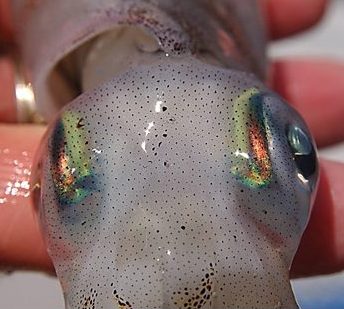 I have been a consistent reader of John McMurray’s contribution to conservefish.org. I have valued his writings due to his activity on the water and his due diligence in obtaining all the facts. With that stated I believe he has overstepped his expertise in his most recent article In Marthas Vineyard & Nantucket, There Ain’t No Stripas. As a writer and council member McMurray has substantial amount of input when it comes to policy changes within the fisheries regulatory arena. Upon reading this piece, I was inspired to write a rebuttal article with the goal of enlightenment and advocacy for the commercial Loligo industry. As a fourth generation commercial fisherman from Point Judith, Rhode Island I have generational knowledge of Doryteuthis pealaeii otherwise known as Loligo, Summer Squid, Longfin Squid and my personal favorite name, Rhode Island’s official appetizer Calamari. Read the rebuttal here by Spencer Bode 14:23
I have been a consistent reader of John McMurray’s contribution to conservefish.org. I have valued his writings due to his activity on the water and his due diligence in obtaining all the facts. With that stated I believe he has overstepped his expertise in his most recent article In Marthas Vineyard & Nantucket, There Ain’t No Stripas. As a writer and council member McMurray has substantial amount of input when it comes to policy changes within the fisheries regulatory arena. Upon reading this piece, I was inspired to write a rebuttal article with the goal of enlightenment and advocacy for the commercial Loligo industry. As a fourth generation commercial fisherman from Point Judith, Rhode Island I have generational knowledge of Doryteuthis pealaeii otherwise known as Loligo, Summer Squid, Longfin Squid and my personal favorite name, Rhode Island’s official appetizer Calamari. Read the rebuttal here by Spencer Bode 14:23
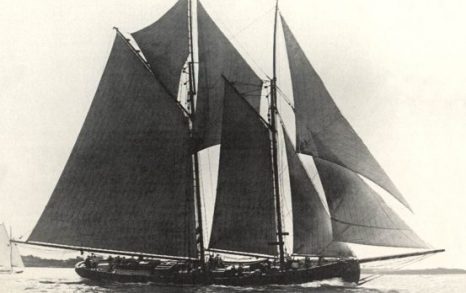
The fishing schooner Mina Swim and crew of 21 never seen again after leaving Burin a century ago
It was a tragedy that left families devastated, and changed Burin forever, but the sinking of the Mina Swim might have been forgotten if not for the work of local residents determined to keep the memory alive. On Tuesday, Burin will mark the 100th anniversary of that tragedy. The fishing schooner Mina Swim left Burin on the afternoon of Feb. 7, 1917, with a crew of 21 on board. It was bound for fishing grounds on the southwest coast of Newfoundland. It was never seen or heard from again. “Back in 1917, the community wouldn’t have been that big, then you have twenty-one of your men taken away in one tragedy,” said Howard Lundrigan, who lost a cousin in the sinking. Eighteen widows and 57 children were left without husbands and fathers. Read the story here 12:27
Proposed Cape Breton Trough Marine Protected Area – Fishermen left in the dark
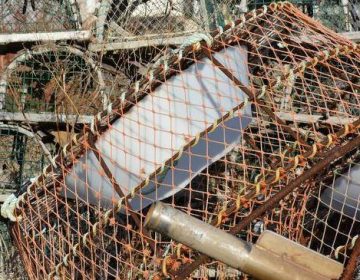 Cape Breton fishermen are concerned that a proposed Marine Protected Area (MPA) off the western coast of the island could result in the closure of the local snow crab fishery. Bill MacDonald, a fisherman for three decades in the region and member of the Area 19 Snow Crab Fisherman’s Association, told the Chronicle Herald the association became aware the government was considering creating an MPA in the fishing region during a meeting with DFO officials last month, but said there’s been no additional information provided since. Because of fishing regulations in other MPAs, MacDonald said he has concerns the $70 million lobster and snow crab fishery that has supported the small coastal region for many generations could be at risk. MPAs are federally designated areas where human activity is limited in order to protect sensitive ecosystems and at-risk species. MacDonald said the association has been left in the dark, not only about the implications for the crab and lobster fishery in the area, but also about why the area is being considered at all. Read the story here 10:10
Cape Breton fishermen are concerned that a proposed Marine Protected Area (MPA) off the western coast of the island could result in the closure of the local snow crab fishery. Bill MacDonald, a fisherman for three decades in the region and member of the Area 19 Snow Crab Fisherman’s Association, told the Chronicle Herald the association became aware the government was considering creating an MPA in the fishing region during a meeting with DFO officials last month, but said there’s been no additional information provided since. Because of fishing regulations in other MPAs, MacDonald said he has concerns the $70 million lobster and snow crab fishery that has supported the small coastal region for many generations could be at risk. MPAs are federally designated areas where human activity is limited in order to protect sensitive ecosystems and at-risk species. MacDonald said the association has been left in the dark, not only about the implications for the crab and lobster fishery in the area, but also about why the area is being considered at all. Read the story here 10:10
HOOKED UP: Red snapper catch share allotment a “retirement plan” for many shareholders
 The most controversial part of the Red Snapper IFQ program may be the part that allows shareholders to sell their yearly allocation. It essentially turns some fishermen into businessmen. Our research has revealed about 120 shareholders – 37 percent of the whole – sell their entire allocation each year. It allows the shareholders to make tens, and in some cases, hundreds of thousands of dollars a year. Galveston commercial fisherman Buddy Guindon defends these fishermen ”It’s his retirement,” he tells us. Slidell commercial fisherman Tommy Williams thinks some of the program needs to be tweaked, but he thinks these shares provide security for retirement fishermen “They worked for the shares,” Williams says. “They were out here, getting their hands cut, cut by fish, bit by fish, baiting hooks. That is their retirement because most fishermen don’t have a 401(k). This is their 401(k).” FOX 8 News sent letters to the fishermen who appeared to be selling their yearly allocations. We heard back from many of them. Read the story here 09:20
The most controversial part of the Red Snapper IFQ program may be the part that allows shareholders to sell their yearly allocation. It essentially turns some fishermen into businessmen. Our research has revealed about 120 shareholders – 37 percent of the whole – sell their entire allocation each year. It allows the shareholders to make tens, and in some cases, hundreds of thousands of dollars a year. Galveston commercial fisherman Buddy Guindon defends these fishermen ”It’s his retirement,” he tells us. Slidell commercial fisherman Tommy Williams thinks some of the program needs to be tweaked, but he thinks these shares provide security for retirement fishermen “They worked for the shares,” Williams says. “They were out here, getting their hands cut, cut by fish, bit by fish, baiting hooks. That is their retirement because most fishermen don’t have a 401(k). This is their 401(k).” FOX 8 News sent letters to the fishermen who appeared to be selling their yearly allocations. We heard back from many of them. Read the story here 09:20
A Time to Build & Refit
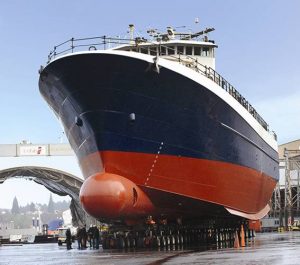 The aging Pacific Northwest fishing fleet is either undergoing or about to undergo a long-overdo upgrade, judging by a major economic report commissioned by the Port of Seattle. Fisheries managers, seafood suppliers, yards and the supply chain all hope an accompanying surge in ship finance “lifts all boats”. For now, the newbuild count is growing apace, slowed just a bit by owners opting for major retrofits amid rich fish harvests. This fisheries upsurge comes with some rising stars of ship design-and-build for vessels set to ply the Bering and Beaufort seas. The ’70s were the heyday of boatbuilding — half of the current U.S. Pacific Northwest’s 400-strong fleet of vessels over 58 feet were built when sideburns were mandatory. The fleet’s boats are so well-maintained, most of them, that they’re still candidates for retrofits of engines, holds, electrical systems and deck machinery. Read the story here 08:14
The aging Pacific Northwest fishing fleet is either undergoing or about to undergo a long-overdo upgrade, judging by a major economic report commissioned by the Port of Seattle. Fisheries managers, seafood suppliers, yards and the supply chain all hope an accompanying surge in ship finance “lifts all boats”. For now, the newbuild count is growing apace, slowed just a bit by owners opting for major retrofits amid rich fish harvests. This fisheries upsurge comes with some rising stars of ship design-and-build for vessels set to ply the Bering and Beaufort seas. The ’70s were the heyday of boatbuilding — half of the current U.S. Pacific Northwest’s 400-strong fleet of vessels over 58 feet were built when sideburns were mandatory. The fleet’s boats are so well-maintained, most of them, that they’re still candidates for retrofits of engines, holds, electrical systems and deck machinery. Read the story here 08:14






